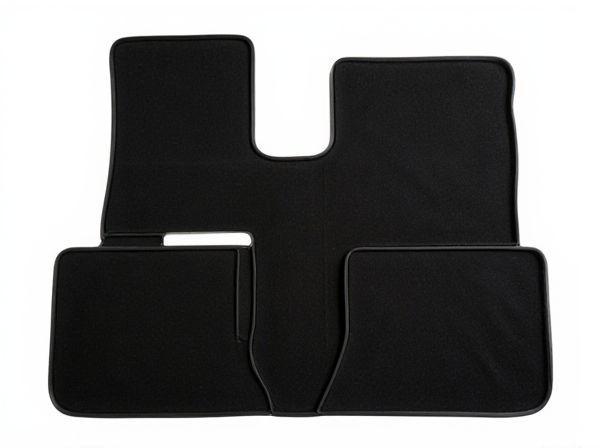
Photo illustration: TPE Mat vs PVC Mat
TPE mats offer superior eco-friendliness and durability compared to PVC mats, making them a better choice for sustainable use. They provide enhanced cushioning and non-slip properties, ensuring a safer and more comfortable workout experience. Your choice between TPE and PVC mats should prioritize environmental impact and comfort based on your fitness needs.
Table of Comparison
| Feature | TPE Floor Mat | PVC Floor Mat |
|---|---|---|
| Material | Thermoplastic Elastomer (TPE) | Polyvinyl Chloride (PVC) |
| Durability | High resistance to wear, tear, and weather | Moderate durability, prone to cracking over time |
| Flexibility | Flexible and maintains shape under pressure | Less flexible, can become rigid in cold temperatures |
| Environmental Impact | Eco-friendly, recyclable, low VOC emissions | Contains harmful chemicals, less eco-friendly |
| Water Resistance | Waterproof, non-absorbent surface | Waterproof but may retain moisture in seams |
| Maintenance | Easy to clean, resists stains and odors | Requires frequent cleaning, prone to odor retention |
| Cost | Higher initial cost, long-term value | Lower upfront price, shorter lifespan |
| Aesthetic | Modern, sleek design options | Basic design, limited style variety |
Introduction: TPE Mat vs PVC Mat
TPE mats offer superior environmental benefits compared to PVC mats, being non-toxic, recyclable, and free from harmful chemicals like phthalates. PVC mats, while affordable and durable, often contain plasticizers that can off-gas harmful substances over time. The choice between TPE and PVC mats impacts user health, sustainability, and overall material performance in fitness and yoga applications.
What is a TPE Mat?
A TPE mat is made from thermoplastic elastomers, a sustainable and non-toxic material known for its durability, flexibility, and eco-friendliness. It offers superior cushioning and resilience compared to traditional PVC mats, making it ideal for yoga, fitness, and floor exercises. TPE mats are highly resistant to moisture, odor, and wear, providing a safe and comfortable surface for extended use.
What is a PVC Mat?
A PVC mat is a floor covering made from polyvinyl chloride, known for its durability, water resistance, and affordability. It offers excellent protection against moisture and is commonly used in high-traffic areas or environments prone to spills. While PVC mats provide solid grip and cushioning, they typically lack the eco-friendly and flexible properties found in TPE mats.
Material Composition and Manufacturing
TPE mats are composed of thermoplastic elastomers, blending rubbery flexibility with thermoplastic recyclability, while PVC mats are made from polyvinyl chloride, a synthetic plastic polymer known for durability and firmness. The manufacturing of TPE mats involves a melting and molding process without harmful additives, emphasizing eco-friendliness and low emissions, whereas PVC mats require plasticizers and stabilizers, which can emit volatile organic compounds (VOCs) during production. Material composition in TPE mats facilitates better elasticity and environmental safety compared to the rigid and chemically intensive manufacturing process of PVC mats.
Eco-Friendliness and Sustainability
TPE mats are more eco-friendly than PVC mats due to their non-toxic, recyclable materials and lower environmental impact during production. PVC mats release harmful chemicals like phthalates and dioxins, which contribute to pollution and pose health risks. Choosing TPE mats supports sustainability by reducing plastic waste and promoting biodegradable alternatives.
Durability and Longevity
TPE mats offer superior durability compared to PVC mats due to their enhanced resistance to tearing, cracking, and deformation under heavy use. The longevity of TPE mats is extended by their non-toxic, eco-friendly composition that resists wear and maintains flexibility over time. In contrast, PVC mats tend to degrade faster, becoming brittle and prone to peeling, which reduces their effective lifespan significantly.
Comfort and Performance
TPE mats offer superior comfort due to their excellent cushioning and elasticity, providing enhanced joint support during workouts compared to PVC mats. Performance-wise, TPE mats are more durable, non-toxic, and eco-friendly, resisting wear and tear while maintaining grip even in sweaty conditions. PVC mats typically lack breathability and cushioning, leading to less comfort and quicker degradation under repeated use.
Safety and Health Considerations
TPE mats offer superior safety and health benefits compared to PVC mats due to their non-toxic, hypoallergenic materials free from harmful chemicals like phthalates and heavy metals. These mats are also more resistant to bacterial growth and mold, promoting a healthier environment for users, especially in fitness and yoga settings. In contrast, PVC mats often contain potentially hazardous additives that can emit volatile organic compounds (VOCs), posing risks to indoor air quality and overall health.
Price Comparison
TPE mats generally cost more than PVC mats due to their eco-friendly, non-toxic materials and enhanced durability. PVC mats are cheaper upfront but may require frequent replacement because they are less resistant to tearing and chemical degradation. Investing in a TPE mat offers better long-term value despite the higher initial price.
Choosing the Right Mat for Your Needs
TPE mats offer superior eco-friendliness, non-toxic properties, and enhanced durability compared to PVC mats, making them ideal for health-conscious users and long-term use in yoga or workout sessions. PVC mats tend to be less expensive and provide good cushioning but may contain harmful chemicals and wear out faster under frequent use. Consider TPE mats for a sustainable, high-performance option or PVC mats for budget-friendly, short-term purposes depending on your fitness routine and environmental priorities.
 caratoz.com
caratoz.com